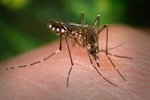The mosquito that is responsible for most of the world’s malaria has been genetically modified to spread genes
that could wipe out its species.
Researchers engineered Anopheles gambiae mosquitoes — which spreads malaria across sub-Saharan Africa — to pass
on genes that cause infertility in female offspring.
The study, published in Nature Biotechnology1, relies on a technology known as a gene drive, and appears two weeks
after a US team reported using the same concept to engineer malaria resistance into a different mosquito species2.
The team, led by molecular biologist Tony Nolan and vector biologist Andrea Crisanti, both at Imperial College London,
identified three genes in Anopheles gambiae that, when mutated, lead to infertility in females.
To be infertile, females must inherit two mutated copies of a fertility gene, one for each chromosome.
(In males, possessing the same mutated genes seems to have no effect on fertility.) Normally,
natural selection would weed out such a harmful trait. Females with two copies of the mutated genes would not breed,
whereas fertile females would tend to pass down healthy versions of the genes to their offspring.
Gene drives, however, ensure that offspring inheriting only one broken copy of a gene automatically have their other chromosome edited,
so that they end up with two mutations. As a result, infertility can spread rapidly through the population.
The work relies on the genome-editing system CRISPR–Cas9.
When a mosquito inherits the DNA that encodes CRISPR–Cas9 along with a mutated gene,
the system copies the genetic alteration from one chromosome to another (see 'CRISPR, the disruptor').
Hacking inheritance
CRISPR–Cas9 has previously been used to develop gene drives in yeast, fruit flies and other mosquitoes;
in a 23 November paper2, molecular biologist Anthony James at the University of California, Irvine, and
his colleagues described a CRISPR–Cas9 gene drive in a South Asian mosquito species
that could spread a malaria-inactivating antibody through a population.
In the laboratory, Nolan and Crisanti designed gene drives that separately targeted each of the three infertility genes
and showed that they worked as expected when introduced into male and female mosquitoes and
bred over several generations: male and female offspring inherited two broken copies of the fertility genes, and
females were left nearly completely infertile.
The researchers also studied how the gene drives might spread in the wild. In cage experiments,
Nolan and Crisanti’s team released 600 mosquitoes,
half of them normal and half carrying an infertility gene drive. After four generations,
75% of the mosquitoes harboured the infertility mutations, in line with theoretical predications about how the trait would spread.
“I really like this paper. It’s a beautiful piece of work,” says Kevin Esvelt,
an evolutionary engineer at Harvard University in Cambridge, Massachusetts,
who studies gene drives in yeast and nematode worms. T
hat is not least, he says, because it was done in a mosquito species
that is responsible for more than 100 million cases of malaria each year and hundreds of thousands of deaths.
Eliminating mosquitoes is more likely to alter ecosystems compared with approaches that equip the insects with malaria resistance,
Esvelt says. But mosquito-elimination strategies will also be more difficult for malaria parasites to overcome
because it would require them to find an entirely new host, he adds.
“It’s hard to imagine that the parasite will not evolve resistance to whatever we do to mosquitoes.”
Few technical hurdles now stand in the way of using gene drives to control malaria, Esvelt says,
underscoring an urgent need to consider how — or even whether — they should be tested in Africa and other regions.
Nolan is circumspect on the prospects of gene drive field trials.
“I think it is time to lay the groundwork and build capacity,” he says. “We’re certainly not rushing to the field next year.”















